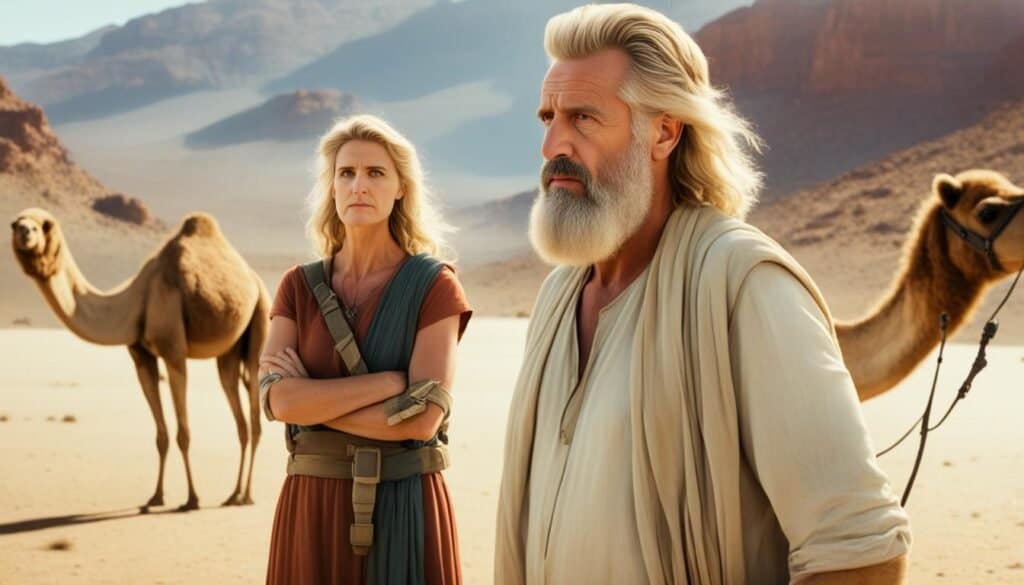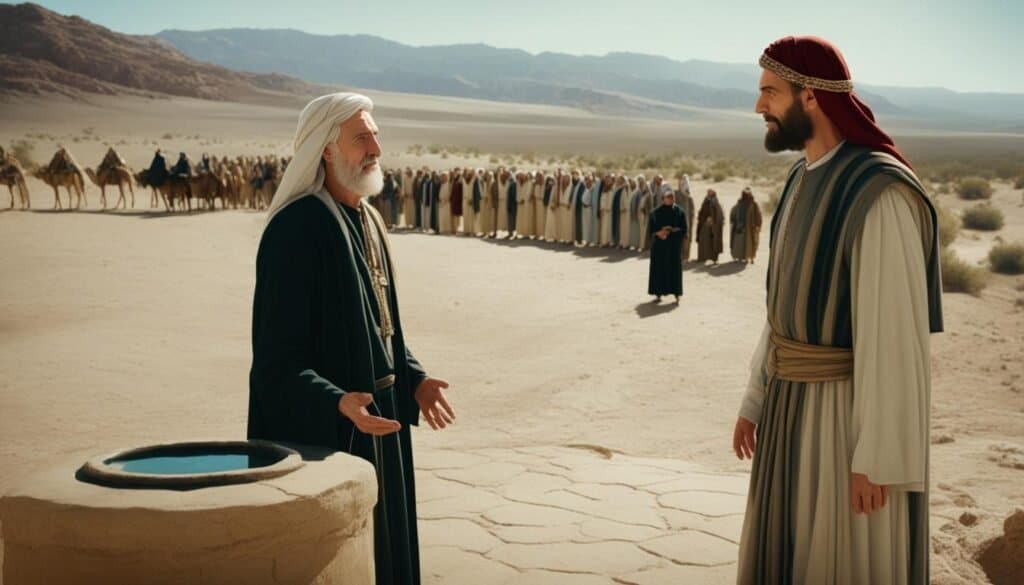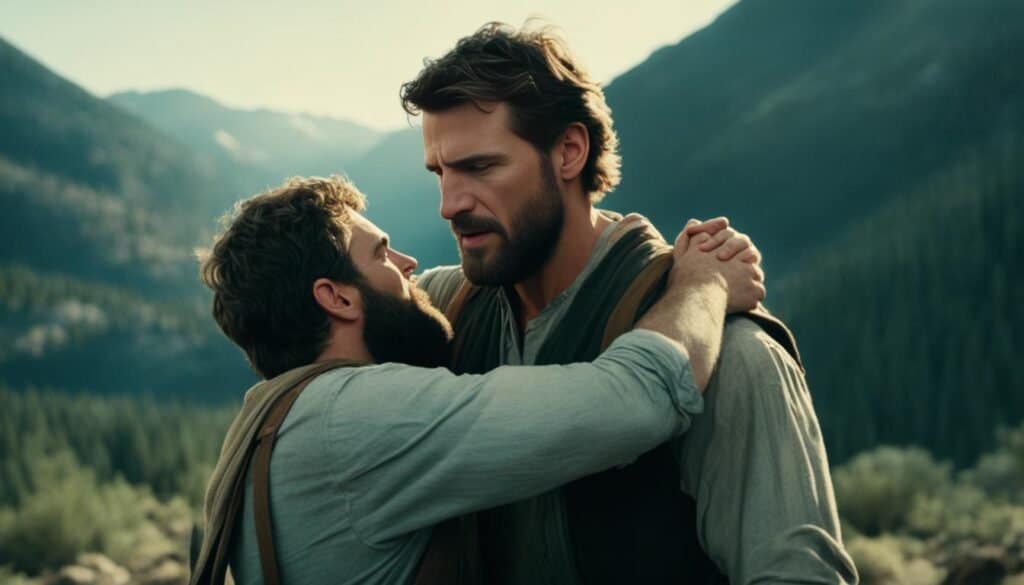Ever thought about how they solved conflicts in olden times? Face conflict in your life now and then? This article looks at the book of Genesis for seven interesting tales. These stories, from Adam and Eve’s issue to Jacob and Esau finding peace, can teach us how to handle our own troubles.
Key Takeaways:
- The book of Genesis provides us with seven key examples of conflict resolution.
- Conflicts in Genesis were resolved through divine intervention and human actions.
- Adam and Eve’s conflict with God resulted in both consequences and care.
- The story of Cain and Abel highlights the tragic resolution of a rivalry.
- Noah and Ham’s conflict showcases the seriousness of disrespect within families.
Adam and Eve’s Disobedience
In Genesis, we learn about the conflict between Adam, Eve, and God. This conflict began with their disobedience in eating from the forbidden tree.
After their mistake, God didn’t leave them. Instead, God made clothes for Adam and Eve and set consequences. Through this act, He showed how to resolve conflicts, teaching us valuable lessons.
Adam and Eve’s story reminds us that even in tough times, there can be a chance for peace. Exploring this story shows us deep lessons about disobedience and how divine help can make things right.
Cain and Abel’s Rivalry
The tale of Cain and Abel highlights a fierce conflict between siblings. This story uncovers the dangers of jealousy, showing how it can lead to terrible outcomes. Cain’s feelings of envy grew when God favored Abel’s gift. As a result, their rivalry turned into a tragic event.
“And the Lord had regard for Abel and his offering, but for Cain and his offering, he had no regard. So Cain was very angry, and his face fell.” – Genesis 4:4-5
In the midst of this tragedy, we notice a moment of mercy and hope. Instead of leaving Cain to his fate, God decided to protect him. God placed a mark on Cain to keep him safe from harm.
While this act didn’t wipe away Cain’s wrongdoings, it shows the power of God’s grace. It proves that even in dire situations, there is room for hope and redemption.

Lessons Learned:
- The destructive consequences of envy: Cain’s jealousy towards Abel serves as a warning. It shows how envy can lead us to make terrible decisions. It reminds us to protect our hearts from such negative feelings.
- The importance of divine intervention: Even in tragic moments, God shows mercy and protection. His involvement offers guidance and a path to resolution in the midst of conflict. Knowing God is with us gives us comfort and hope.
- The potential for redemption: Cain’s story teaches us about second chances and transformation. It illustrates how God’s grace can turn a story of mistakes into one of hope and renewal. It inspires us to seek peace and reconciliation in our own lives.
Noah and Ham
We’re going to talk about Noah and his son Ham. It’s all about the massive problem disrespect can cause in a family. Ham did something hurtful by seeing and telling people about his drunk, naked father. This action broke the trust and love between Noah and Ham.
The issue here shows how bad disrespect is for family ties. Noah did something after what Ham did. He asked for things to be made right. So, God stepped in and dealt with it by bringing a curse on Canaan, Ham’s kid.
“Cursed be Canaan! The lowest of slaves will he be to his brothers.” – Genesis 9:25
This curse really shows how huge a deal it is to respect your family, especially parents. It tells us to remember to honor and listen to our family. This lesson is a big one for generations to come.
The Significance of Conflict Resolution
Noah and Ham’s story teaches us a lot about fixing fights. It reminds us that even in old times, families had issues that messed with their closeness. Fixing these problems was key, just like Noah and Ham did.
By dealing with our troubles, we get to make things right and get closer again. This tale is a good reminder that solving problems is necessary for happy families and peace.
Abraham, Sarah, and Hagar
Sarah and Hagar didn’t get along because of their shared connection to Ishmael, Abraham’s first son. We’ll see how this tough situation was resolved. Divine help and Abraham’s actions played a big role.
Sarah suggested that since she couldn’t have children, Hagar should have one for Abraham instead. Ishmael became Hagar’s son, causing trouble between the two women. Sarah was upset and felt Hagar mistreated her. This led to a serious issue in their home.
God eventually stepped in to help. He told Abraham to listen to Sarah and let Hagar and Ishmael go. This choice was hard but ensured they wouldn’t suffer. God also promised to take care of Ishmael, making his future bright.
Divine guidance and resolution
“I will surely bless you, and I will surely multiply your offspring so that they shall be as numerous as the stars of heaven and as the sand that is on the seashore. And your offspring shall possess the gate of his enemies.” (Genesis 22:17-18)
This divine help solved the Sarah-Hagar problem and showed a path for Ishmael. Although it was difficult for Abraham to let them go, God’s pledge carried hope and a clear destiny.
The story of Abraham, Sarah, and Hagar highlights the value of looking for guidance from a higher power in solving conflicts. Abraham’s following of God’s directions showed his deep faith and trust in God.

Abraham’s Treaty with Abimelech
In Genesis, Abraham’s workers and King Abimelech’s people had a problem about a well. Abimelech’s workers said the water was theirs when Abraham’s team dug a well. Abraham wanted to solve this without a fight and talked to Abimelech to work it out.
Both Abraham and Abimelech knew they had to fix this fast to keep peace. They made a treaty to live peacefully. As part of this peace deal, Abraham gave Abimelech seven female lambs.

This agreement showed they valued peace more than winning. They taught a lesson in ending fights without making things worse. They showed making deals is better than fighting.
“Let there be no strife between you and me, and between your herdsmen and my herdsmen, for we are kinsmen.” – Genesis 26:24
Terms of the Treaty
The peace deal had a few important parts:
- Non-aggression: They promised not to be mean or violent to each other.
- Shared resources: Both could use the well, so everyone had water.
- Respect: They agreed to respect each other and what they owned.
- Peaceful coexistence: The treaty aimed for everyone to live together without fighting.
This peace deal stopped the fight over the well. It’s a good lesson in talking things out and finding solutions together. It shows that even tricky problems can be solved with talks and agreements.
| Parties Involved | Treaty | Key Terms |
|---|---|---|
| Abraham | Treaty with Abimelech | Non-aggression, shared resources, respect, peaceful coexistence |
| Abimelech | Treaty with Abraham | Non-aggression, shared resources, respect, peaceful coexistence |
Jacob and Esau’s Reconciliation
The story of Jacob and Esau is a powerful one. It shows how conflict can be turned into peace. Jacob had taken his brother’s blessing and birthright through trickery. This caused a deep and long lasting bitterness between them.
But Jacob chose to seek peace with Esau after many years. He was afraid of the unresolved conflict between them. Jacob sent gifts to Esau, showing his wish for peace. This act of kindness and humility paved the way for reconciliation.
“Please accept the present that was brought to you, for God has dealt graciously with me, and because I have enough.” And he urged him, and he took it.
When Jacob and Esau finally met, it was a moving moment. Jacob bowed to his brother, showing respect. This simple yet profound act set the stage for forgiveness.
Esau’s heart was touched by Jacob’s humility and gifts. He forgave him and they embraced. Tears of joy were shed. This marked the end of their conflict and the start of a new chapter in their relationship based on love and forgiveness.
This story teaches us important lessons on resolving conflicts. It reminds us about the power of humility and forgiveness. Even after grave mistakes, it shows that true remorse can lead to healing and renewed bonds.

Lessons from Jacob and Esau’s Reconciliation
This story challenges us to mend our own conflicts through sincere effort. It encourages us to seek peace and forgiveness in our relationships. We’re inspired to deal with our conflicts with grace and a heart willing to reconcile.
- Foster humility: Jacob’s act of bowing down before Esau signifies a humble heart that acknowledges the pain caused and the need for reconciliation.
- Show remorse: Genuine remorse, accompanied by tangible actions, can create a path towards forgiveness and healing.
- Seek forgiveness: Jacob’s approach to Esau with gifts and humility exemplifies the importance of taking the first step towards reconciliation by acknowledging the pain caused and seeking forgiveness.
- Embrace forgiveness: Esau’s reaction of forgiveness and reconciliation reminds us of the transformative power of letting go of resentment and embracing forgiveness.
- Build on love and empathy: Jacob and Esau were able to rebuild their relationship by prioritizing love, empathy, and understanding.
The account of Jacob and Esau’s reconciliation in Genesis is deeply inspiring. It urges us to handle our conflicts with a spirit of grace and humility. By doing so, we can hope to mend broken relationships and find peace.
| Lessons from Jacob and Esau’s Reconciliation |
|---|
| Foster humility |
| Show remorse |
| Seek forgiveness |
| Embrace forgiveness |
| Build on love and empathy |
How Do Power Struggles and Conflicts Over Blessing Reflect Conflict Resolution in Genesis?
In Genesis, the narrative unfolds through epic battles for blessings, showcasing the deep-seated conflicts among siblings, such as Jacob and Esau. These struggles reveal underlying themes of favoritism and divine promise, ultimately leading to a profound exploration of conflict resolution that shapes the destinies of the characters involved.
Jacob’s Sons and Shechem
In Jacob’s sons and Shechem’s story, we see a tough social issue emerge. Shechem, a prince, wrongs Dinah, Jacob’s daughter. This raises big questions about how to handle conflicts in the Bible.
Trying to fix things with a marriage didn’t work. This conflict shows us that solving big issues isn’t easy. It teaches us to act with kindness, be fair, and think carefully in tough times.
Reflecting on this story helps us learn about solving conflicts. It tells us how vital it is to admit wrong, seek fairness, and aim for peace. Jacob’s sons and Shechem’s story show us why facing conflicts is crucial and how we can follow the Bible’s teachings to find peace.
Affiliate Disclosure: "As an Amazon Associate I earn from qualifying purchases made from links in this post. We are a participant in the Amazon Services LLC Associates Program, an affiliate advertising program designed to provide a means for us to earn fees by linking to Amazon.com."

